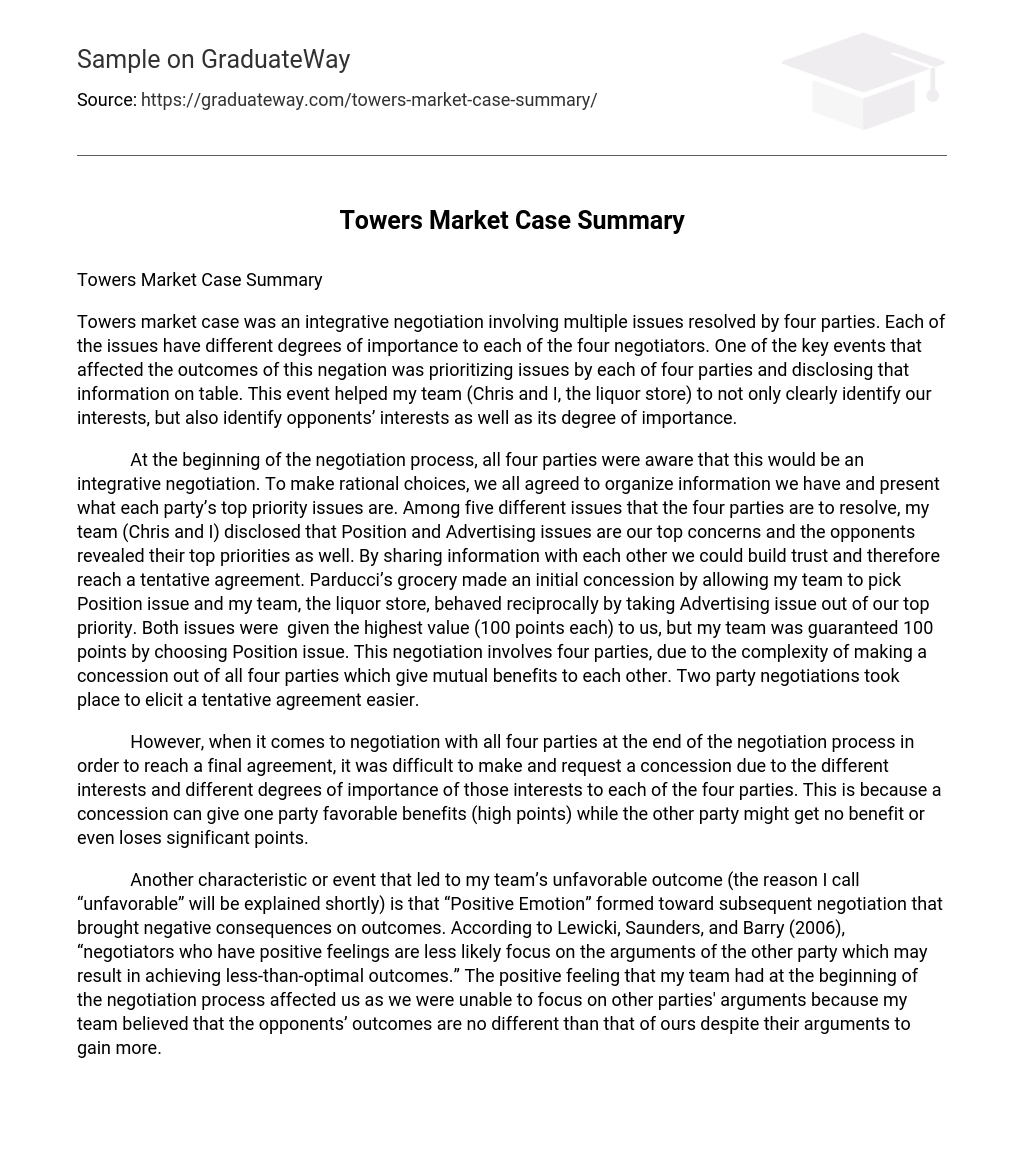Towers market case was an integrative negotiation involving multiple issues resolved by four parties. Each of the issues have different degrees of importance to each of the four negotiators. One of the key events that affected the outcomes of this negation was prioritizing issues by each of four parties and disclosing that information on table. This event helped my team (Chris and I, the liquor store) to not only clearly identify our interests, but also identify opponents’ interests as well as its degree of importance.
At the beginning of the negotiation process, all four parties were aware that this would be an integrative negotiation. To make rational choices, we all agreed to organize information we have and present what each party’s top priority issues are. Among five different issues that the four parties are to resolve, my team (Chris and I) disclosed that Position and Advertising issues are our top concerns and the opponents revealed their top priorities as well. By sharing information with each other we could build trust and therefore reach a tentative agreement. Parducci’s grocery made an initial concession by allowing my team to pick Position issue and my team, the liquor store, behaved reciprocally by taking Advertising issue out of our top priority. Both issues were given the highest value (100 points each) to us, but my team was guaranteed 100 points by choosing Position issue. This negotiation involves four parties, due to the complexity of making a concession out of all four parties which give mutual benefits to each other. Two party negotiations took place to elicit a tentative agreement easier.
However, when it comes to negotiation with all four parties at the end of the negotiation process in order to reach a final agreement, it was difficult to make and request a concession due to the different interests and different degrees of importance of those interests to each of the four parties. This is because a concession can give one party favorable benefits (high points) while the other party might get no benefit or even loses significant points.
Another characteristic or event that led to my team’s unfavorable outcome (the reason I call “unfavorable” will be explained shortly) is that “Positive Emotion” formed toward subsequent negotiation that brought negative consequences on outcomes. According to Lewicki, Saunders, and Barry (2006), “negotiators who have positive feelings are less likely focus on the arguments of the other party which may result in achieving less-than-optimal outcomes.” The positive feeling that my team had at the beginning of the negotiation process affected us as we were unable to focus on other parties’ arguments because my team believed that the opponents’ outcomes are no different than that of ours despite their arguments to gain more.
Sometimes in negotiation, how well the other parties had done affect the satisfaction of opponent negotiators when they evaluate the outcomes. If one party doesn’t know the outcomes of the other party, the former evaluates his/her outcome equally whereas he/she feels less positive about his/her outcome if one found out that the other had done better (Thompson, 1995). My team achieved far more points (130 points) than resistance point (50 points) and we were satisfied with our outcomes. Since it is an integrative negotiation, all four parties were happy about their outcomes and no one party behaved as if he/she is sole winner of this negotiation. However, upon finding out other parties’ outcomes later in the classroom, especially learning that the grocery party earned most points out of four parties (200 points), I was less satisfied with my team’s favorable outcome and I started to feel negative about other party. I figured it is not good to know the opponents’ result after the negotiation is done, especially if there is possibility to meet that party again in future negotiations.
One big mistake my team had in this negotiation was that perceiving this negotiation purely as an integrative negotiation instead of perceiving it as a combination of integrative and distributive negotiation. When four parties made a tentative agreement (each got one issue worth 100 points), it was a process of acquisition of pie in a cooperative way. Once all parties ensured that they got at least 100 points each, they looked for the ways to expand their pie of available resources. My team was not aware of expanding pie with distributive strategies, therefore, ended up with lowest points among four parties involved in this case.
If I have a chance to work in this type of negotiation in the future, I would ask for post-settlement settlements which would give me a final chance to enhance previously settled outcomes. I will also employ more communications skill such as questioning and listening as well as interpreting feedback of other parties to find more trade-off opportunities.





